2017 AUDI TT ROADSTER child restraint
[x] Cancel search: child restraintPage 204 of 314
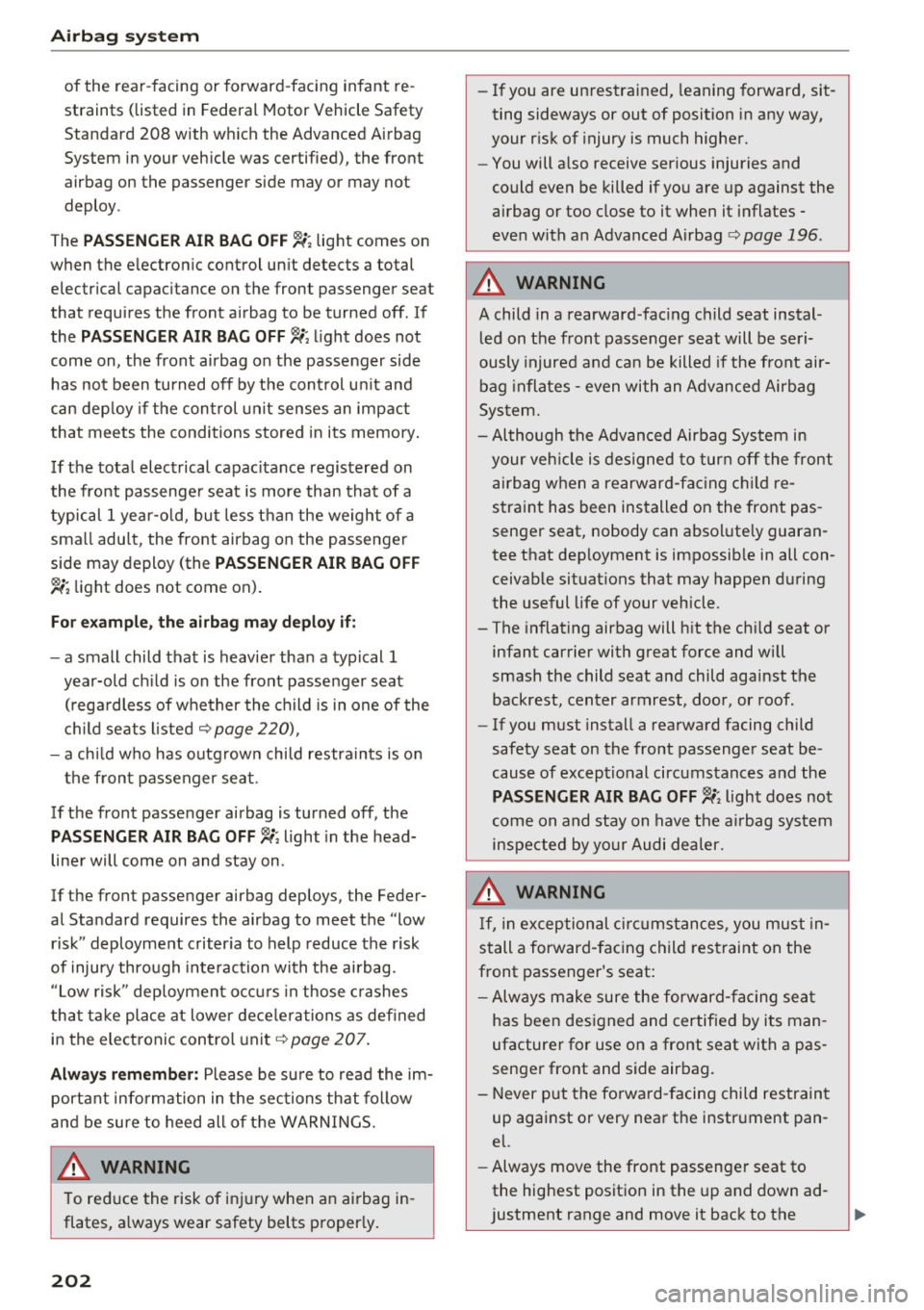
Airbag syste m
of the rear -facing or forward-facing infant re
straints (listed in Federal Motor Vehicle Safety
Standard 208 with wh ich the Advanced Airbag
System in your vehicle was certified), the front a irbag on the passenger side may or may not
deploy .
The
P A SSENGER AIR BAG OFF ~ ; light comes on
when the e lectron ic control un it detects a total
electrical capacitance on the front passenger seat
that requires the front airbag to be turned off. If
the
PASSEN GER AIR BA G OFF ~; light does not
come on, the front airbag on the passenger side has not been turned off by the control u nit and
can dep loy if t he con trol unit senses an impact
that meets the conditions stored in its memory.
If the tota l electrical capac itance registered on
the front passenger seat is more than that of a
typical 1 year-old, but less than the weigh t of a
small adu lt, the front airbag on the passenger
side may deploy (the
PASSENGER AIR BAG OFF
~ ; light does not come on) .
For example, the airbag may deploy if :
- a small child that is heavier than a typical 1
year-old ch ild is on the front passe nger seat
( r ega rdless of whether the child is in one of the
c hi ld se ats l isted
q page 220),
- a chi ld who has outg rown child restraints is on
t h e front passenger seat.
If the front passenger airbag is turned off, the
PASSENGER A IR BA G OFF ~; light in the head
line r will come on and stay on .
If the front passenger airbag deploys, the Feder
al Standard requires the airbag to meet the "low
risk " deployment criteria to help reduce the risk
of injury through inte raction with the airbag.
" Low risk" deployment occu rs in those c rashes
t hat take place at lower dece le rations as defined
in the electronic control unit
q page 207.
Alway s rememb er: Please be su re to read the im
portant information in the sections that follow
and be sure to heed all of t he WARNINGS.
A WARNING
To red uce the risk of inj ury when an airbag in
flates, a lways wear safety belts properly .
202
-If you are un restrained, leaning forward, sit
ting sideways or out of position in any way,
your risk of injury is much higher.
- You will a lso receive ser ious injuries and
could even be killed if you are up against the
airbag or too close to it when it inflates -
even with an Advanced Airbag
¢ page 196 .
A WARNING
A child in a rearward -facing child seat instal
led on the front passenger seat will be seri
ously injured and can be killed if the front air
bag inflates -even with an Advanced Airbag
Sys tem.
- Although the Advanced Airbag System in
your veh icle is designed to turn off the front
airbag when a rearwar d-fac ing ch ild re
straint has been installed on the front pas
senger seat, nobody can absolutely guaran
tee that dep loyment is impossib le in all con
ceivab le situat ions that may happen du ring
the useful life of your vehicle.
- The inflating airbag will h it the ch ild seat or
infant carrier with great force and will
smash the child seat and child against the
backrest, center armrest, doo r, or roof .
- If you must install a rearward facing child
safety seat on the front passenger seat be
cause of excep tional circumstances and the
PASSENGER AIR BAG OFF~; light does not
come on and stay on have the a irbag system
inspected by your Audi dealer.
A WARNING
I f, in ex ceptional ci rcums tances, you must in
stall a forward-facing child restraint on the
front passenger's seat:
- Always make sure the forward-facing sea t
has been des igned and certified by its man
ufacturer for use on a front seat with a pas
senger front and side airbag.
- Never put the forward -facing child restraint
up against or very nea r the instrument pan
el.
- Always move the front passenger seat to
the highest position in the up and down ad
justment range and move it back to the
Page 205 of 314
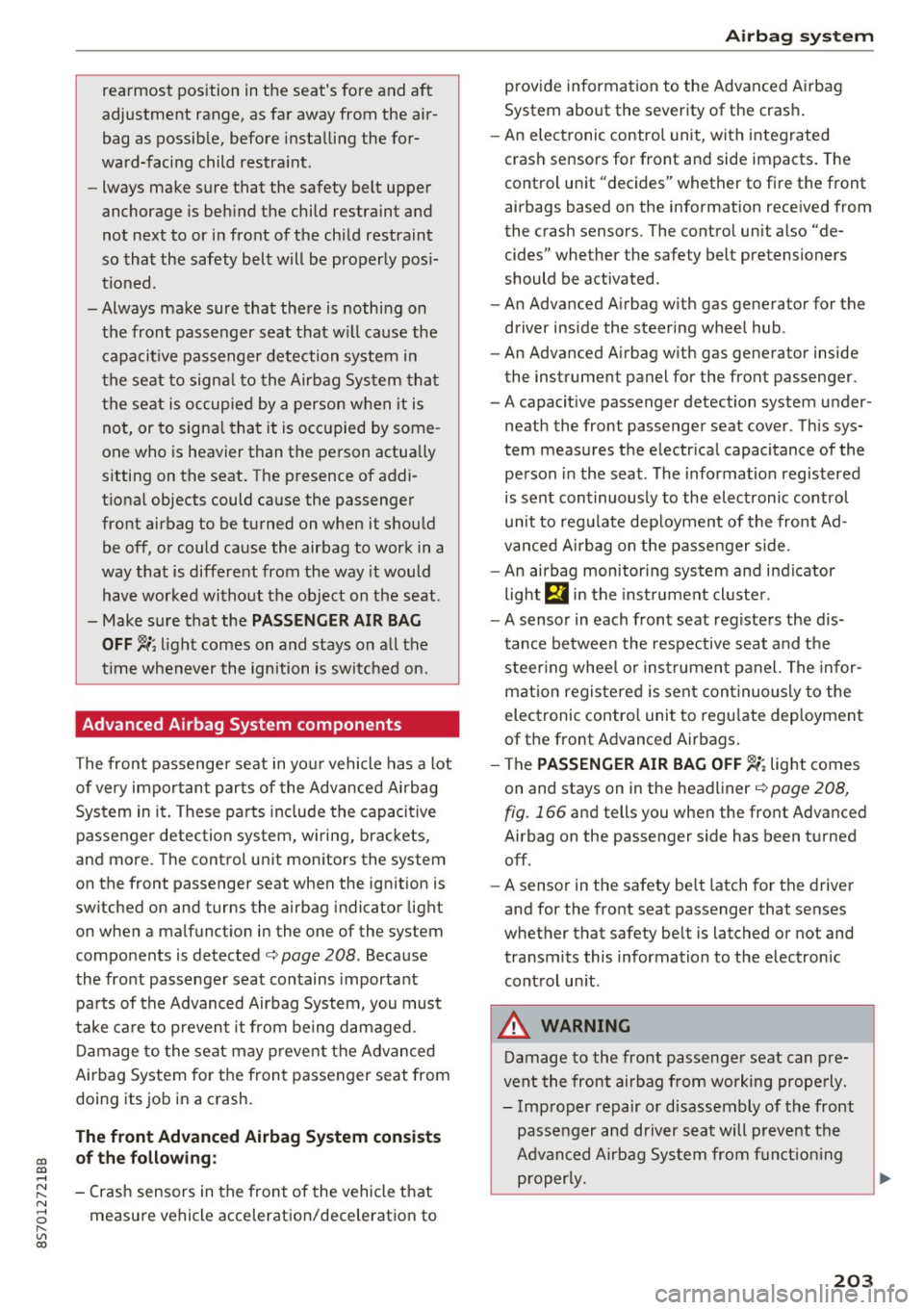
co
co
.... N
" N .... 0
" "' c:o
rearmost position in the seat's fore and aft
adjustment range, as far away from the air
bag as possible, before insta lling the for
ward-facing child restra int.
- lways make sure that the safety belt upper
anchorage is beh ind the child restraint and
not next to or in front of the child restraint
so that the safety belt will be properly pos i
tioned.
-Always make sure that there is nothing on the front passenger seat that w ill cause the
c apacit ive passenger detection system in
the seat to signa l to the Airbag Sys tem tha t
the seat is occupied by a person when it is
not, or to signa l that it is occ upied by some
one who is heavier than the person actua lly
sitting on the seat . The p resence of addi
t ional objects could cause the passenger
front airbag to be turned on when it shou ld
be off, or could cause the airbag to work in a
way that is different from the way it would
have worked witho ut the object on the seat.
- Make sure that the
PASSENGER AIR BAG
OFF ~;
light comes on and stays on a ll the
t ime whenever the ignition is switched on.
Advanced Airbag System components
The front passenger seat in yo ur vehicle has a lot
of
very important parts of the Advanced Airbag
Sys tem in it . These pa rts in cl ude the capacitive
passenger detection system, w iring, brackets,
and mo re. The control un it monitors the system
on the front passenger seat when the ign ition is
switched on and turns the airbag indicator light
on when a malfunct ion in the one of the system
components is detected
c::> page 208 . Because
the fro nt passenger seat contains important
pa rts of the Advanced Airbag System, you must
take ca re to preven t it from being damaged.
D amage to the seat may p revent the Advanced
Ai rbag System for the front passenger seat from
doi ng its job i n a crash.
The front Advanced Airbag System consists
of the follow ing :
- C rash sensors in the front of the vehicle that
measure vehicle accelerat ion/dece leration to
Airb ag sys tem
provide information to the Advanced A irbag
System about the severity of the cras h.
- An elect ronic contro l unit, with integrated
cras h sensors for front and side impacts . The
control un it "decides" whether to fire the front
airbags based on the information rece ived from
the crash sensors . The control unit also "de
cides" whether the safety belt pretensioners
should be activated.
- An Advanced A irbag w ith gas generator for the
driver inside the steeri ng wheel hub .
- An Advanced A irbag w ith gas generator inside
the instrument panel for the front passenger.
-A capacit ive passenger detection system under
neath the front passenger seat
cover. This sys
tem measures the e lectr ica l capacitance of the
person in the seat. The information registered
is sent continuously to the elect ronic contro l
un it to reg ulate dep loyment of the front Ad
vanced Airbag on the p assenger side.
- An airbag monitoring system and indicator
light
El in the inst rument cl uste r.
- A sensor in each front seat registe rs the d is
t ance betwee n the respective seat and the
steer ing whee l o r ins trumen t pa nel. The infor
mat ion registered is sent con tinuous ly to the
electronic contro l unit to regu late dep loyment
of the front Advanced Airbags .
- The
PASSENGER AIR BAG OFF~; lig ht comes
on and stays on in the headliner
c::> poge 208,
fig. 166 and tells you when the front Advanced
Airbag on the passenger side has been turned off.
- A sensor in the safety belt latch for the driver
and for the front seat passenger that senses
whether that safety be lt is latched or not and
transmits this information to t he electronic
cont rol un it .
A WARNING
Damage to the front passenge r seat can pre
vent the front airbag from working prope rly.
- Imp roper repair or d isassembly of the front
passenger and driver seat will p revent the
Advanced Airbag Sys tem from f unct ion ing
p roper ly. ...,
203
Page 206 of 314

Airbag syste m
-Repairs to the front passenger seat must be
performed by qua lified and properly trained
workshop personnel.
- Never remove the front passenger or driver
seat from the vehicle.
- Never remove the upholstery from the front
passenger seat.
- Never disassemble or remove parts from the
seat or disconnect wires from it.
- Never carry sharp objects in your pockets or
put them on the seat . The capacitive pas
senger detection mat in the front passenger
seat will not function properly if it is punc
tured.
- Never carry things on your lap or carry ob
jects on the front passenger seat. Such ob
jects can influence the capac itance regis
tered by the capac itive passenger detection
system, so that incorrect information is pro
vided to the airbag control unit.
- Never store items under the front passenger
seat. Parts of the Advanced Airbag System
under the passenger sea t could be dam
aged, preven ting them and the airbag sys
tem from working properly.
- Never place seat covers o r rep lacemen t up
holstery that have not been spec ifically ap
proved by Audi on the front seats.
- Seat covers can prevent the Advanced Air
bag System from recogn izing child re
straints or occupants on the front passenge r
seat and prevent the side airbag in the seat
backrest from dep loying proper ly.
- If a seat heater has been retrofitted or oth
erwise added to the front passenger seat,
never install any ch ild restraint system on
this seat.
- Never use cush ions, pillows, blankets, or
similar items on the front passenger seat.
The add itiona l layers prevent the capacitive
passenge r detection system from accurate ly
measuring the capac itance of the ch ild safe
ty seat and/or the pe rson on the seat and
t hu s keep the Advanced Airbag System from
wor king p roperly.
- Never place o r use any electrical device
(s uch as a laptop, CD player, elec tronic
games dev ice, power inverte r or seat he ater
204
for child seats) on the front passenger seat
if the device is connected to the 12-volt
socket or the cigarette lighter socket. Such
dev ices can influence the capac itance regis
tered by the capacitive passenger detection
system, so that incorrect informat ion is pro
vided to the airbag cont ro l unit.
- If you must use a child restra int on the front
passenger seat and the child restra int man
ufacturer's instructions requ ire t he use of a
towel, foam c ushion or someth ing else to
proper ly posit ion the child restra int, make
certa in that the
PASSENGER AIR BAG OFF
,; ; light comes on and stays on whenever
the child restraint is insta lled on the front
passenger seat.
- If the
PASSENGER AIR BAG OFF,;, light
does not come on and stay on, have the air bag system inspected by your Audi dealer.
A WARNING
If the front passenger seat gets wet, dry it immediately .
- If liq uid soaks into the front passenger seat,
this can keep the airbag system from work
ing proper ly and may, for instance, deacti
vate the passenger frontal airbag. If this
happens, the
PASSENGER AIR BAG OFF,;,
light will come on and stay on together w ith
t he airbag indica to r li gh t
min the instru
ment cluster.
'
- I f liq uid is pooled on the seat, but has not
soaked in, th is may also keep the airbag sys
tem from working p roperly and cause the
passenger fronta l airbag to be enabled
(turned on), even though there is a properly
installed child restraint system on the seat.
Wet towels or other wet things on the seat
cushion can have the same effect. If the
front passenger frontal airbag is turned o n,
the
PASSENGER AIR B AG OFF ,;, light light
w ill go out.
How the Advanced Airbag System
components work together
The front Advanced Airbag System and the side
airbags supp lement the protection offered by the .,,.
Page 210 of 314
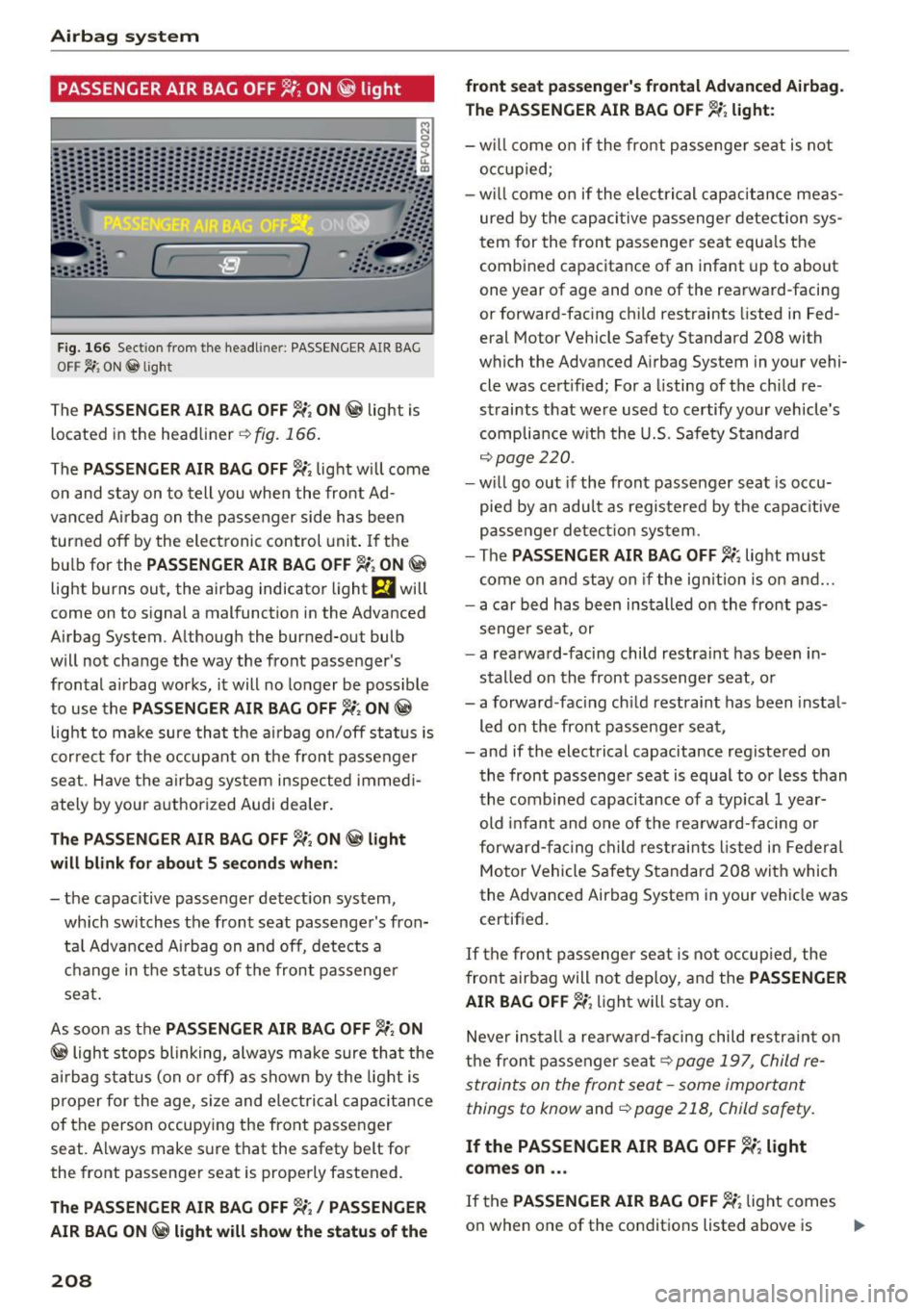
Airbag system
PASSENGER AIR BAG OFF 1!; ON @ light
F ig. 166 Sect ion from the headl iner: PASSENGER AIR BAG
O FF ~ ON@lig ht
The PASSENGER AIR BAG OFF~; ON @ light is
located in the he adliner
~ fig. 166 .
The PASSENGER AIR BAG OFF~; light w ill come
on and stay on to tell you whe n the front Ad
vance d Ai rbag on t he passenger side h as been
turned off by the electronic control uni t. If the
bu lb for the
PASSENGER AIR BAG OFF 1i , ON @
light burns out, the airbag indicator light El will
come on to signal a malfunction in the Advanced
Airbag System. A lthough the burned-out bulb
w ill not change t he way the front passenger 's
fron ta l airbag works, it will no lo nger be possible
to use the
PASSENGER AIR BAG OFF~; ON @
light to ma ke sure tha t the ai rbag on/off s tat us is
corre ct for the occup ant on the fron t passe nger
se at. H ave the airbag system inspected immed i
ately by your a uthorized Audi dea ler.
The PASSENGER AIR BAG OFF~; ON @ light
will blink for about 5 seconds when:
- the capacitive passenger de tect ion sys tem,
which sw itches the front seat passenge r's fron·
tal Adv anced Ai rb ag on and off, detect s a
c h ange in t he sta tus of the front passenge r
sea t.
As soo n as the
PASSENGER AIR BAG OFF ~; ON
@ ligh t stop s blinking, always ma ke sure tha t the
air bag statu s (on or off) as shown by t he light is
p roper for the age, s ize and ele ct ric al c ap acitance
of the person occupy ing the front passe nger
seat . A lways make s ure that the safety belt for
the front passenge r seat is prope rly fasten ed.
The PASSENGER AIR BAG OFF ~; / PASSENGER
AIR BAG ON@ light will show the status of the
208
front seat passenger's frontal Advanced Airbag.
The PASSENGER AIR BAG OFF~; light:
- will c om e o n if the fr ont pas senge r seat is not
o ccupi ed;
- will c ome o n if the ele ctric al c apac itance meas·
ured by the capaci tive pas senger detectio n sys·
t ern for the fron t passenge r se at equ als the
combined capacitance of an infant up to about
one year of age and one of the rea rwa rd-faci ng
or forward -fac ing c hild rest raints listed in Fed
eral Motor Vehicle Safety Standard 208 with
which the Advanced A irbag System in your vehi·
cle was cert ified; For a listing of the ch ild re·
strai nts that we re us ed to certify yo ur vehicle's
complia nce w it h t he U.S . Safe ty S tanda rd
¢ page 220 .
-will go out if the front p assenge r seat is occu
pie d by an adu lt as regis te re d by the capac itive
passe nger detect io n sys tem.
- The
PASSENGER AIR BAG OFF~; light mus t
come on and sta y on if the ig nition i s on a nd ...
- a ca r bed has been ins talled o n the front pas·
senge r sea t, or
- a rea rwa rd -facing child restrain t has been in·
s talled on the front passenger s eat, or
- a forward -fac ing ch ild restraint has been insta l·
led on the fro nt passenger sea t,
- and if the electrical capacitance registe red on
the front passenge r seat is equal to or less than
t he co mbine d capacitance of a typical 1 y ear·
old inf ant and o ne of th e rea rw ar d-facing or
forw ard-fa cing c hild r estra in ts l iste d in Fe deral
Moto r Vehicle S afety S tandar d 208 with which
the Adva nced Airbag System in your veh icle was
certif ied.
If t he fron t passenger se at i s not occup ied, the
fr ont airba g will not deploy, a nd the
PASSENGER
AIR BAG OFF~;
light w ill stay on .
Neve r ins tall a rea rw ar d-f a cing child res tra int on
th e fr on t passenger sea t
¢ page 19 7, C hild re
s traints on the front seat -some importan t
things to know
and ¢ page 21 8, Child safety .
If the PASSENGER AIR BAG OFF ~; light
comes on ...
If th e PASSENGER AIR BAG OFF~; ligh t comes
o n when one of the condit ions listed above is
Ill-
Page 211 of 314

co
co
.... N
" N .... 0
" "' c:o
met, be sure to check the light regularly to make
certain that the
P A SSENGER AIR BAG OFF '-1;
light stays on continuously whenever the ignition
is on. If the
PAS SENGER AIR BAG OFF '-1; light
does not appear on and does not stay on all the
time, stop as soon as it is safe to do so and
- reactivate the system by turning the ign ition
off for more than 4 seconds and then turning it
on again;
- remove and reinstall the child restraint. Make sure that the child restraint is properly installed and that the safety belt for the front pas
senger seat has been correctly routed through
the child restraint as descr ibed in the child re
straint manufacturer's i nstructions;
- make sure that the convertible locki ng retrac
tor on the safety be lt for the front passenger
seat has bee n activated and that the safety belt
has been pulled tight.
- make sure that no electrical device (such as a
laptop, CD player, electronic games device,
power inverter or seat hea ter for child seats) is
placed or used on the front passenger seat if
the device is connected to the 12•volt socket or
the cigarette lighter socket;
- make sure that no seat heater has been retro
fitted or otherwise added to the front passen
ger seat;
- make sure that nothing can interfere with the
safety belt buckles and that they are not ob
structed;
- make sure that there are no wet objects (such
as a wet towel) and no water or other liquids on
the front passenger seat cush ion.
If the PASSENGER AIR BAG OFF~; light st ill
doe s not come on ...
If the PAS SENGER AIR BA G OFF '-1; light sti ll
does not come on and does not stay on continu
ously (when the ignition is sw itched on),
- take the child restraint off t he front passenger
seat and have the airbag system inspected by
your Audi dealer immed iate ly.
Th e PASSENGER AIR BAG OFF~; light
should NOT come on ...
The PA SSENGER AIR BAG OFF ~ ; light should
NOT come on when the ign ition is on and an
Airb ag sys tem
adult is sitting in a proper seating pos ition on the
front passenger seat. If the
PASSENGER AIR
BAG OFF~;
light comes on and stays on whi le
driv ing, under these c ircumstances, make sure
that:
- the adult on the front passenger seat is proper
ly seated on the center of the seat cushion w ith
his or her back up against the backrest and the backrest is not reclined,
- the adult is not taking we ight off the seat by
holding on to the passenger assist handle
above the front passenger door or support ing
their weight on the armrest,
- the safety belt is being properly worn and that
there is not a lot of slack in the safety belt web
b ing ,
- there are no aftermarket seat covers or cush
ions or other things (such as blankets) on the
front passenger seat that might cause the ca pacitive passenge r detection system to miscal
culate e lectr ica l capaci ta nce.
' Important safety instructions on
monitoring the Advanced Airbag System
A WARNING
--- If the stat us of the Advanced Airbag System
has changed while the vehicle is moving, the
PASSENGER AIR BAG OFF '-1; ON @ light
blin ks for about 5 seconds to cat ch the driv
er 's attent ion . If this happens, a lways stop
as soon as it is sa fe to do so and check the
steps described above .
- If the
PASSENGER AIR BAG OFF~; light
does not go off when an adult who is not
very small is sitting on the front passenger
seat after tak ing the steps described above,
have the airbag system inspected by your
author ized Audi dealer before t ransporting
anyone on the front passenger seat .
A WARNING ....._
An airbag system that is not functioning prop
e rly cannot prov ide supplemental protect io n
i n a fronta l crash.
- If the ai rbag ind icator light
<=:> page 14
comes when the veh icle is being used, have
209
Page 212 of 314
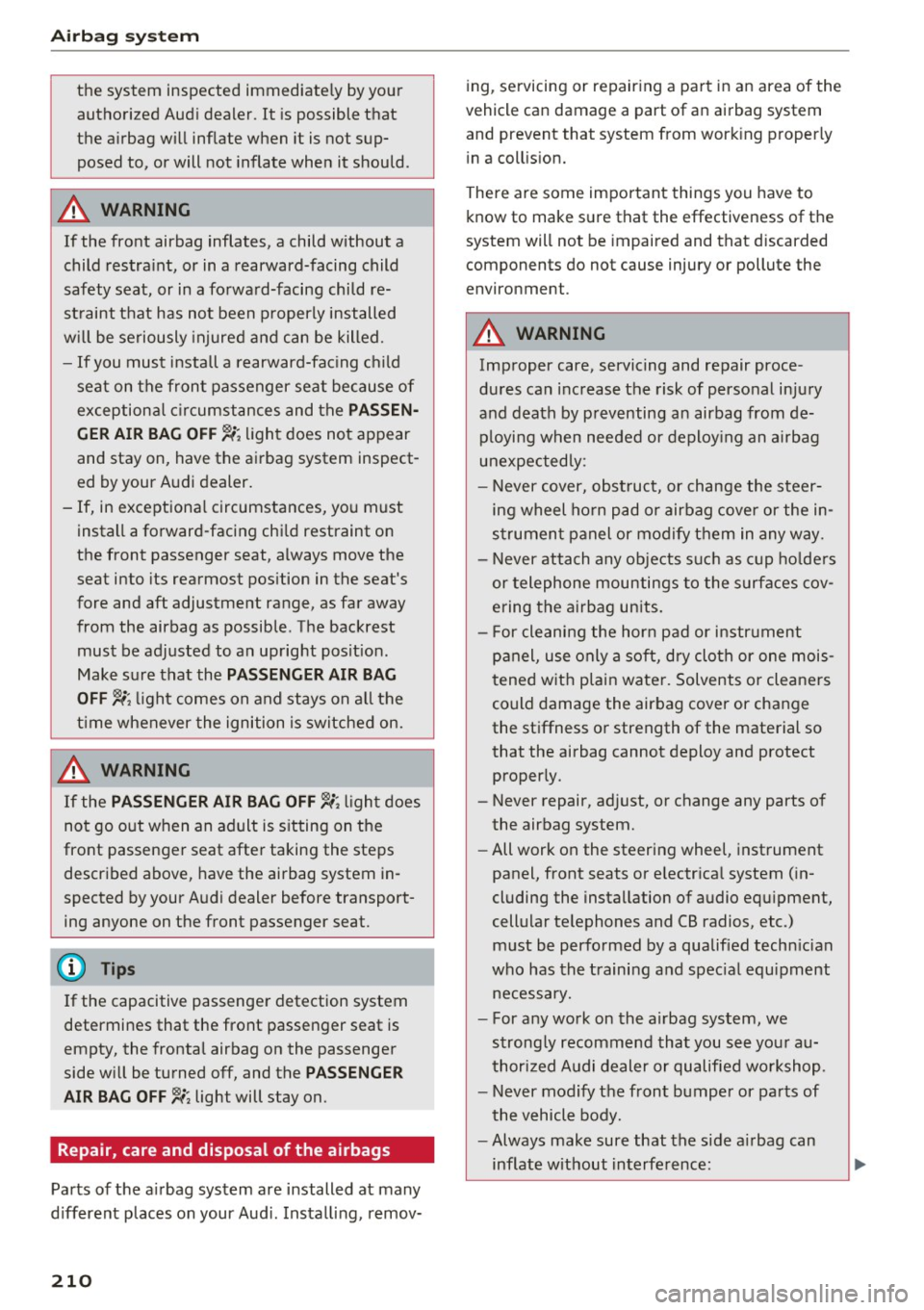
Airbag syste m
the system inspected immediately by your
authorized Audi dealer. It is possible that
the airbag will inflate when it is not sup
posed to, or will not inflate when it should.
A WARNING
If the front airbag inflates, a child without a
child restra int, or in a rearward-facing child
safety seat, or in a forward-facing child re
straint that has not been properly installed
w ill be seriously injured and can be killed.
- If you must install a rearward-fac ing child
seat on the front passenger seat because of
exceptional c ircumstances and the
PA SSEN
G ER AIR BAG OFF,;;
light does not appear
and stay on, have the airbag system inspect
ed by your Audi dealer.
- If, in exceptional circumstances, you must
install a forward-facing chi ld restraint on
the front passenger seat, always move the
seat into its rearmost pos ition in the seat's
fore and aft adjustment range, as far away
from the airbag as possible. The backrest
must be adjusted to an upright posit ion.
Make s ure that the PASSENGER AI R BAG
OFF ,;;
light comes on and stays on a ll the
t ime whenever the ignition is switched on.
A WARNING
If the PAS SENGER AIR BAG OFF~; light does
not go out when an adult is s itting on the
front passenger seat afte r taking the steps
described above, have the airbag system in
spected by your Audi dealer before transport
ing anyone on the front passenger seat.
(D Tips
If the capacitive passenger detection system
determines that the front passenger seat is
empty, the frontal airbag on the passenger
side w ill be turned off, and the
PA SSENGER
AIR BA G OFF ~;
light will stay on.
Repair, care and disposal of the airbags
Parts of the a irbag system are installed at many
d ifferent places on your Aud i. Instal ling, remov-
210
ing, servicing or repairing a part in an area of the
vehicle can damage a part of an airbag system
and prevent that system from work ing properly
i n a coll is ion.
There are some important things you have to know to make sure that the effectiveness of the
system will not be impaired and that discarded
components do not cause injury or pollute the
environment.
A WARNING
Improper care, servicing and repair proce
dures can increase the risk of personal injury
and death by preventing an airbag from de
p loying when needed or deploy ing an a irbag
unexpectedly:
-
- Never cover, obstruct, or change the steer
ing wheel ho rn pad or airbag cover or the in
strumen t panel or modify them in any way.
- Never attach any objects such as cup ho lde rs
or telephone mountings to the surfaces cov
ering the a irbag un its.
- For cleaning the horn pad or instr ument
panel, use only a soft, dry doth or one mois
tened w ith plain water. Solvents or cleaners
could damage the airbag cover or change
the st iffness or strength of the material so
that the airbag cannot deploy and protect proper ly.
- Never repair, ad just, or change any parts of
the airbag system.
- All work on the steering wheel, inst rument
panel, front seats or e lectr ica l system (in
cluding the installation of audio equ ipment,
cellular te lephones and CB radios, etc.)
m ust be perfo rmed by a qualified techn ician
who has the training and spec ial equipment
necessary.
- For any work on the airbag system, we
strong ly recommend tha t you see you r au
thori zed A udi dealer or qualified wo rkshop.
- Never modify the front bumper or pa rts of
the vehicle body.
- Always make sure that the side a irbag can
inflate w ithout interfe rence:
Page 215 of 314
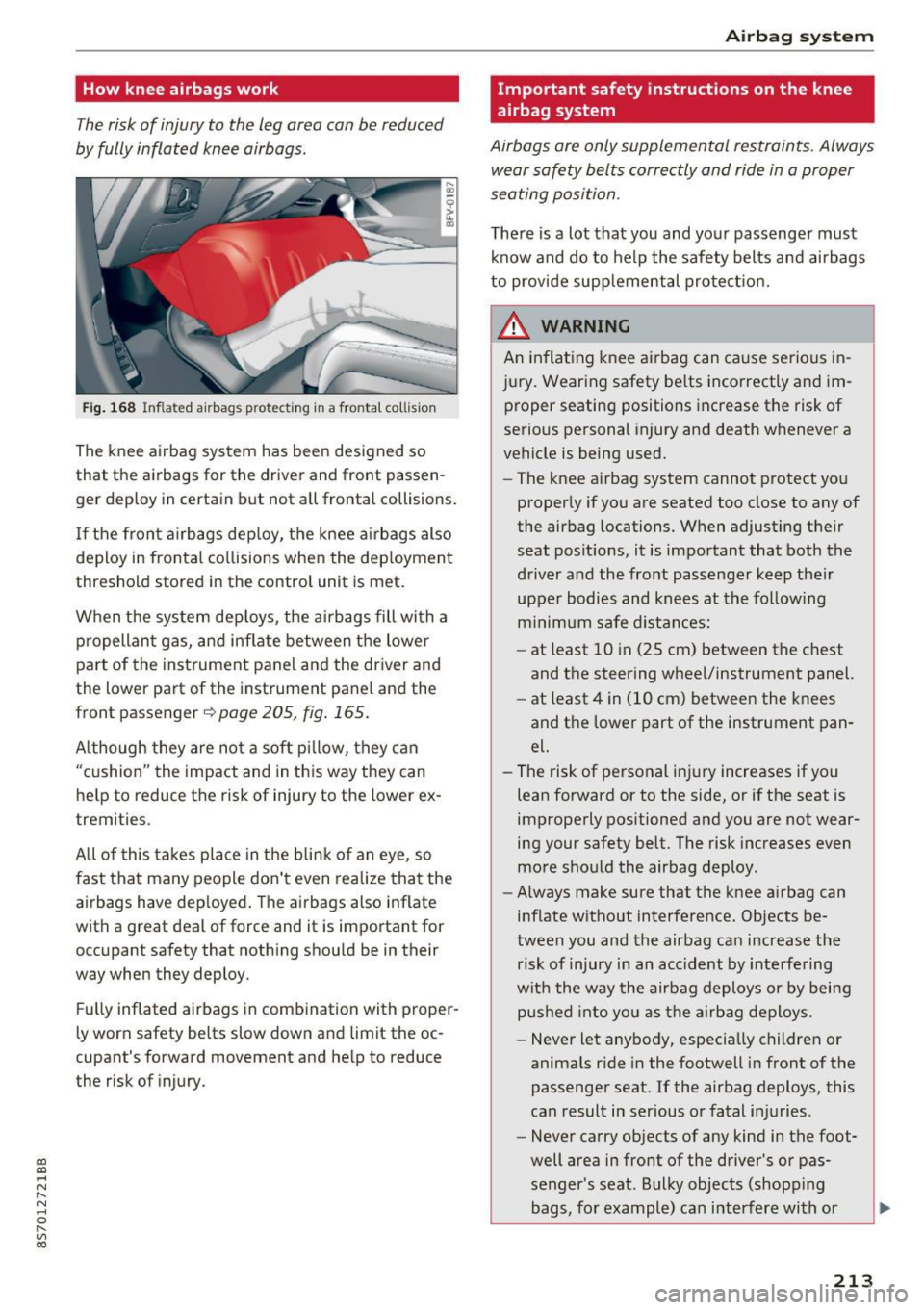
CD
CD
.... N
" N ,....,
0 r--. V, co
How knee airbags work
The risk of injury to the leg area can be reduced
by fully inflated kn ee airbags.
Fig . 168 Inflated airbags protecting in a fronta l collision
The knee airbag system has been designed so
that the airbags for the driver and front passen ger deploy in certain but not all frontal collisions .
If the front airbags dep loy, the knee ai rbags also
deploy in fronta l co llisions when the dep loyment
threshold stored in the contro l unit is met.
When the sys tem dep loys, the airbags fill with a
propellan t gas, and inf late between the lowe r
part of the instrument panel and the driver and
the lower pa rt of the instrument panel and the
front passenger ¢
page 205, fig. 165.
Although they are not a soft pi llow, they can
"c ushion" the impact and in this way they can
he lp to reduce the risk of injury to the lower ex
tremities.
All of this ta kes place in t he b lin k of an eye, so
fast that many people don't even realize that the
airbags have dep loyed . The airbags also inflate
with a great deal of force and it is important for
occupant safety that nothing should be in their
way when they deploy .
F u lly inflated airbags in combination with proper
ly worn safety belts slow down and limit the oc
cupant 's forward movement and help to reduce
the r isk of injury.
Airb ag sys tem
Important safety instructions on the knee
airbag system
Airbags are only supplemental restraints . Always
wear safety belts correctly and ride in a proper
seating position .
There is a lot that you and yo ur passenger must
know and do to help the safety belts and ai rbags
to provide supp lemental protect ion.
A WARNING ~
An inflat ing knee a irbag can cause se rious in-
jury. Wearing safety be lts incorrectly and im
proper seating positions increase the risk of
serious personal injury and death whenever a
vehicle is being used.
- The knee airbag system cannot protect yo u
proper ly if yo u are seated too close to any of
the airbag locations. When adjusting t heir
seat pos itions, it is important that both the
driver and the front passenger keep their
uppe r bodies and knees at the fo llow ing
m inim um safe d istan ces:
- at least 10 in (25 cm) between the chest
and t he steering wheel/instrument panel.
- at least 4 in (10 cm) between the knees
and t he lower part of the instrument pan
el.
- The risk of personal inj ury increases if you
lean forward or to the side, or if the seat is
improperly positioned and you are not wear
ing your safety belt. The risk increases even
more should the airbag deploy .
- Always make sure that the knee a irbag can
inflate w ithout interference. Objects be
tween you and the airbag can increase the risk of injury in an accident by inte rfe ring
wit h the way the airbag deploys or by bei ng
pushed into yo u as the ai rbag deploys.
- Never let anybody, especially children or
anima ls r ide in the footwell in front of the
passenger seat. If the airbag deploys, this
can result in serious or fatal i njuries .
- Never carry objects of any kind in the foot
well a rea in front of the driver's or pas
senger's seat. Bulky objects (shopp ing
bags, fo r example) ca n in terfere with or
~
213
Page 216 of 314
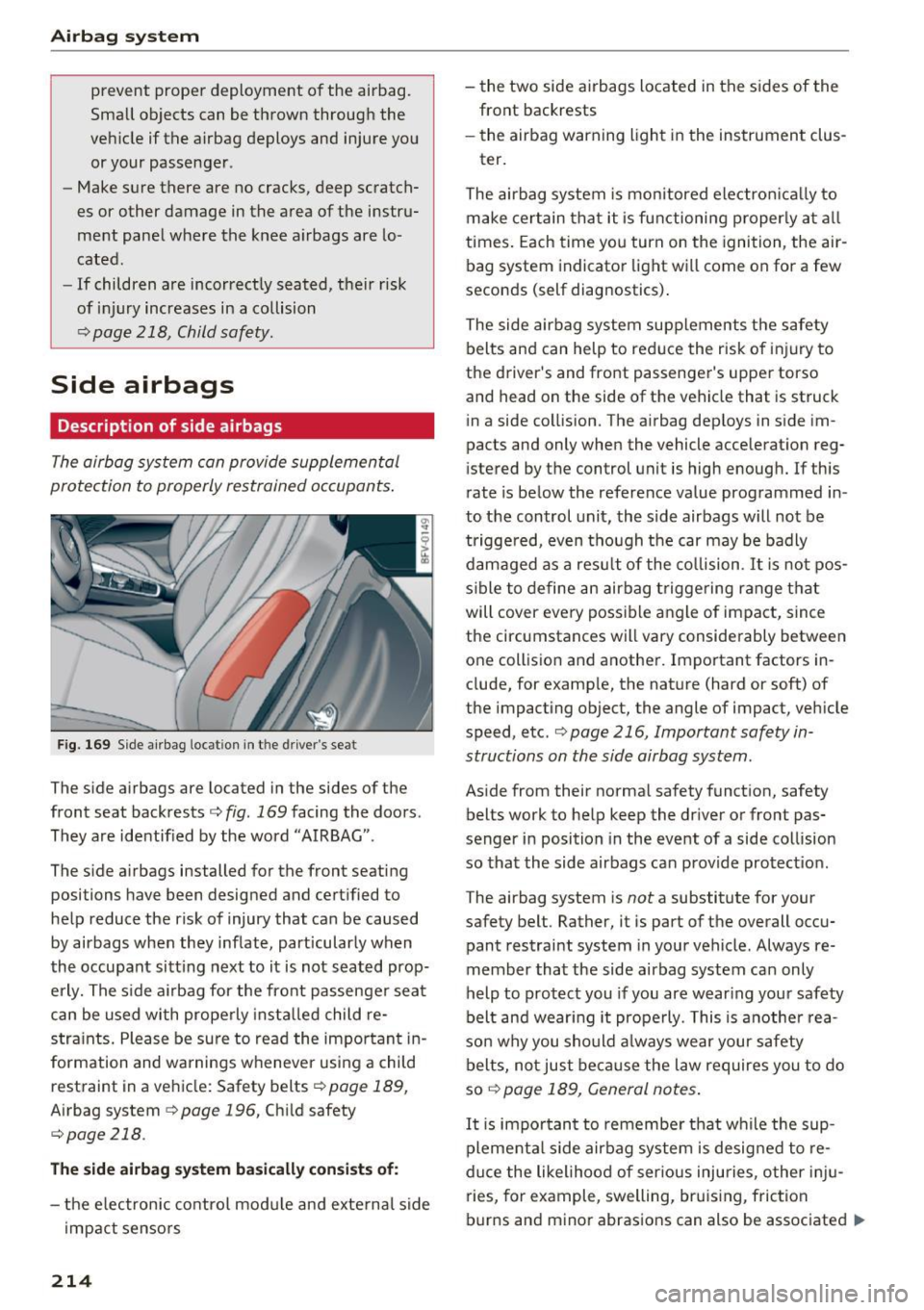
Airbag system
prevent proper deployment of the airbag.
Small objects can be thrown through the
vehicle if the airbag deploys and injure you
or your passenger .
- Make sure there are no cracks, deep scratch
es or other damage in the area of the instru
ment panel where the knee airbags are lo
cated.
- If children a re incorrect ly seated, their risk
of injury increases in a collision
c::> page 218, Child safety.
Side airbags
Description of side airbags
The airbag system can provide supplemental
protection to properly restrained occupants.
F ig. 169 Side airbag locat ion in t he drive r's seat
The side airbags are located in the sides of the
front seat backrests
c::> fig. 169 facing the doors .
They are identified by the word "AIRBAG".
The side airbags installed for the front seating
positions have been designed and certified to
help reduce the risk of injury that can be caused
by airbags when they inflate, particularly when
the occupant sitting next to it is not seated prop
erly. The side airbag for the front passenger seat
can be used with properly installed child re
straints. Please be sure to read the important in
formation and warnings whenever using a child
restraint in a vehicle: Safety belts
c::> page 189,
Airbag system c::>page 196, Child safety
c::> page 218 .
The side airbag system basically consists of:
- the electronic control modu le and external side
impact sensors
214
- the two side airbags located in the sides of the
front backrests
- the airbag warning light in the instrument clus-
ter.
The airbag system is mon itored electron ical ly to
make certain that it is functioni ng p roperly at all
times. Each time you turn on the ignition, the air
bag system indicator light will come on for a few
seconds (self diagnostics) .
The side airbag system supplements the safety
belts and can help to reduce the risk of injury to
the driver's and front passenger's upper torso
and head on the side of the vehicle that is struck
in a side collision. The airbag deploys in side im
pacts and only when the vehicle acceleration reg
istered by the control unit is high enough. If this
rate is below the reference value programmed in
to the control unit, the side airbags will not be
trigge red, even though the car may be badly
damaged as a result of the collision .
It is not pos
sible to define an airbag triggering range that
will cover every possible angle of impact, since
the circumstances will vary conside rably between
one collision and another. Important factors in
clude, for example, the nature (hard or soft) of
the impacting object, the angle of impact, vehicle
speed, etc.
c::> page 216, Important safety in
structions on the side airbag system .
Aside from their normal safety function, safety
belts work to help keep the driver or front pas
senger in position in the event of a side collision
so that the side airbags can provide protect ion.
The airbag system is
not a substitute for your
safety belt. Rather, it is part of the overall occu
pant restraint system in your vehicle . Always re
member that the side airbag system can only
help to protect you if you are wear ing your safety
belt and wear ing it properly. This is another rea
son why you sho uld always wear your safety
belts, not just because the law requires you to do
so
c::> page 189, General notes.
It is impo rtant to remember that while the sup
plemental side airbag system is desig ned to re
duce the likelihood of ser ious injuries, other inju
ries, for example, swelling, bruising , friction
burns and minor abrasions can also be associated ..,.